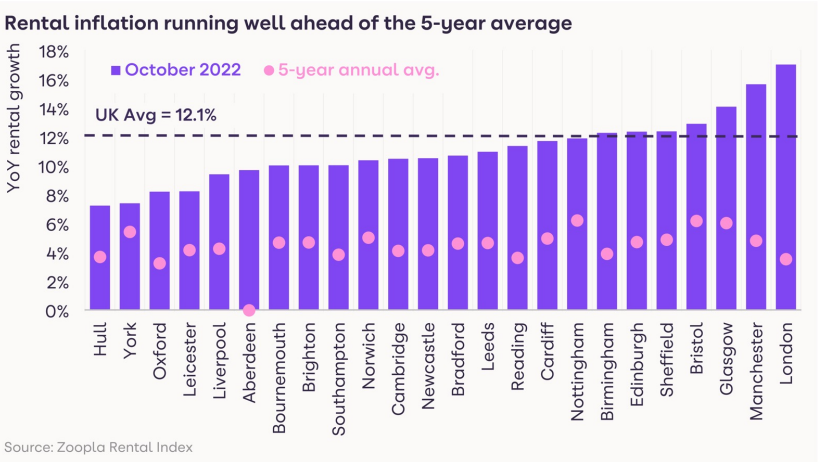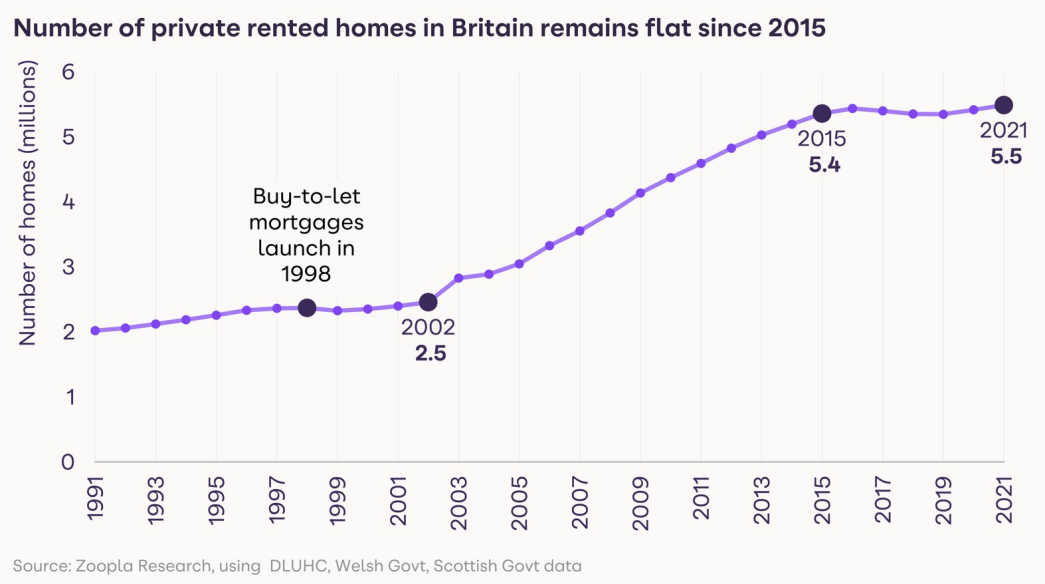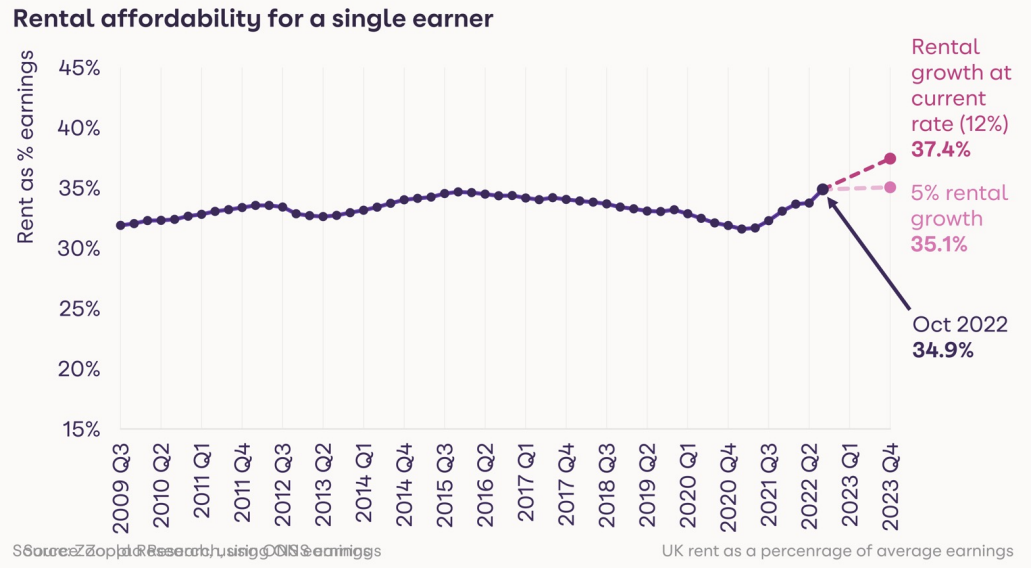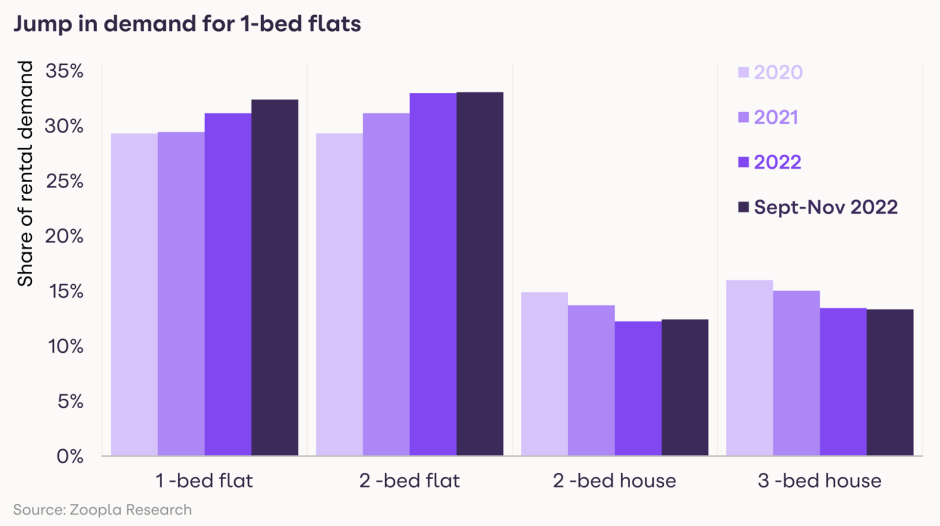HomeTrack publish their latest UK Rental Market Report (December 2022)
HomeTrack publish their latest UK Rental Market Report (December 2022), giving their insights into the state of the market, based on Zoopla’s Rental Index.
Key points from publication:
-
- Rental inflation is 12.1% per annum, well ahead of earnings (6%)
- No sign of a slowdown due to chronic supply/demand mismatch
- Demand is 46% above average while total supply is 38% lower
- Rents in the largest UK cities are registering the fastest growth rates
- Rental (un)affordability for a single earner is at its highest for over a decade (35% of average weekly earnings)
- Demand for one-bed flats jumps as renters seek better value
- Stretched rental affordability will start to hit demand and the pace of rent increases in H1 2023
- Rent growth to slow to 4-5% by the end of 2023
|
Annual change in rents, UK |
Rent as percentage of earnings (single person) |
Rental inflation over 2023 |
|
+12.1% |
35% |
4%-5% |
Chronic supply/demand imbalance
The rental market continues to face a chronic imbalance between supply and demand. Demand-side pressures are being exacerbated by rising mortgage rates limiting access to homeownership for first-time buyers. Rental enquiries per estate agency branch are 46% above the 5-year average.
There has been a modest increase in rental supply in recent weeks as the sales market weakens. The average number of homes for rent per estate agency branch is 10, up from a low of 7 at the end of September. However, the stock of homes for rent remains 38% below the 5-year average and 4% below November 2021.
No sign of rent inflation slowing in the short term
Rising demand and a lack of supply mean rents are increasing quickly, up 12.1% over the last 12 months to October 2022. This is an increase of £117 per month or £1,400 a year. The underlying data shows no sign of any immediate slowdown, with rental inflation in the 3 months to October 2022 (3.6%) being the highest quarterly gain since December 2021.
It is important to draw a distinction between rental inflation for new lettings i.e. when the property becomes vacant and its rent is adjusted in line with the market, and rental inflation for all private rented homes. 1 in 4 renters move home each year and this group will experience rental inflation in line with new lettings.
For the 75% of renters that do not move each year, rental increases are much lower at 3.8% in the year to October 2022 1 – slower than the growth in average earnings. The chart compares the rental inflation rate for new lettings versus all private rented homes based on the ONS Index of Private Housing Rental Prices. This variance is why more renters are staying put, to avoid higher rental payments when they move, and further compounding supply problems.
Big cities register the highest levels of rental inflation Rents are increasing fastest in the largest UK cities, led by London where rents are up 17% or £273 per month over the last 12 months.
HomeTrack’s index is recording above-average rental inflation in other big regional cities, including Manchester (+15.6%), Birmingham (+12.3%), Glasgow (+14.1%), Bristol (+12.9%) and Sheffield (+12.4%). These cities are seeing demand exceed supply over the last year, being major employment centres with large student populations. Not all cities are registering rapid gains, with Hull, York, Oxford and Leicester recording slower growth of less than 8% – although still higher than the rate of earnings growth (6% to September 2022).
The key question is: ‘When will rental inflation start to slow to more sustainable levels?’ The current momentum in rental levels is a growing concern for all private renters, especially those on low incomes, as it exacerbates cost-of-living pressures. Rental inflation will only slow if demand weakens or supply increases significantly, or if we see a combination of the two.
Structural undersupply of private rented homes
The quickest way to slow rental inflation is to boost rental supply. Unfortunately, we do not expect any major improvement over the next 12 months. The private rented sector has a structural supply problem stemming from economic and policy factors. The stock of homes for rent has not grown in size since 2016, holding steady at c.5.5m homes. Over the last 7 years, we have seen private landlords rationalising their portfolios, selling some assets in the face of higher taxes and facing greater regulation, while some have taken advantage of a strong sales market. This reduction in rented homes has been offset by new investment from cashflow-focused private landlords and corporate investors delivering ‘build-to-rent’ schemes.
Higher mortgage rates have shifted the economics of buy-to-let investing, limiting new purchase volumes which could add to rental supply. Proposed regulations and new rules on renting homes that are not at an Energy Efficiency rating of C or better from 2025 are likely to result in more private landlords selling up homes that are expensive to manage and retrofit. This will offset the impact of new investment.
We do, however, expect some modest improvement in rental supply as the sales market weakens. Landlords looking to sell homes may now continue to rent them out while uncertainty in the wider sales market lasts. Rental supply will increase but not sufficiently to drive a material slowdown in rental inflation in isolation.
Rental (un)affordability to hit demand and growth rate
While rental demand increases in times of economic uncertainty, the affordability of renting is set to have the greatest influence on how much rental inflation can slow down over 2023.
Rents tend to track earnings over the long run and therefore rental inflation in line with earnings is sustainable. While earnings growth has accelerated, rental growth has been outpacing earnings for over a year (June 2021). This means rental affordability, measured by rent as a percentage of average earnings (for a single earner), is now at its highest level for a decade at 35%. This national pattern is replicated across many regions and countries of the UK, except for London, the South-East and Eastern England where it is just short of the all-time high recorded in 2015/16.
If rental growth were to continue to run at 12% over 2023, the proportion of earnings needed to pay rent would be stretched even higher to 37%. This is not likely or feasible and we expect the growing unaffordability of renting to hit spending power. This trend, supported by a modest improvement in available supply, could lead to rental growth slowing to 5% over 2023.
Renters forced to look for smaller homes or share
Faced with growing affordability pressures, renters have several options. One is to share to help spread the cost of renting for single person households and low earners. The latest English Housing Survey (2020/21) shows that there is an equal 50:50 split between private renters with multiple incomes (couples or multi-person households) and single earners (single person or lone parents). We expect more sharing in the face of high rents and a particular squeeze on single earner households.
Recent research from the Resolution Foundation 2 found that there has been a steady increase in sharing, measured by the space per private renter which has decreased by 16% over the last two decades. More sharing will support underlying rental growth in the short term, but this impact will start to slow in markets where this option has been fully utilised. Data is not available to quantify this trend. We suspect the impact of sharing on rents has been greatest in London and to a lesser degree in other regions/cities.
Another option for young, single people faced with high rental costs is to stay at home with parents or relatives. ONS data 3 shows a continued increase in the number of young adults aged 20-34 years staying at home (3.6m in 2021) rather than incurring rental payments to live independently. This trend is already helping to ease some of the current demand-side pressures.
Finally, renters could down-trade to smaller homes. Our last report highlighted how renters are seeking smaller homes with an increase in demand for 1- and 2-bed flats and a reduction in demand for houses. Our latest data shows this trend is continuing with an acceleration in demand for 1-bed flats, which now accounts for 32% of rental enquiries and has been seen nationally. The affordability dynamics for a couple renting a 1-bed flat are much better than a 2- bed home and keeping a spare room or sub-letting.
Outlook
The private rental market is an important housing tenure and plays a key role in the operation of the UK housing market. It provides flexibility for those who are unable or unwilling to buy. It is a particularly significant tenure for younger households and supports labour market flexibility. It is also increasingly important for older households in middle age and later in life.
A prolonged period of lower net-new investment in rented homes, together with a rationalisation of landlord portfolios, has seen the growth in rental supply stall over recent years. Increasing demand is pushing rents higher and adding to affordability pressures for renters. This means more renters are having to consider a greater set of compromises when looking to secure a home.
Policymakers need to better understand the rental market as well as the forces and factors shaping the overall availability of supply. The demand for rented homes is only going to rise in the medium term, so it’s important we encourage more supply from all forms of landlords, whether private individuals or large corporates. It is important that policymakers encourage good landlords of all types and sizes to stay in the market and deliver much-needed supply. Only by increasing investment in the private rented sector can we ease the affordability pressures on renters in the medium term and make for a more sustainable rental market.
Kindly shared by HomeTrack
Main photo courtesy of Pixabay






















